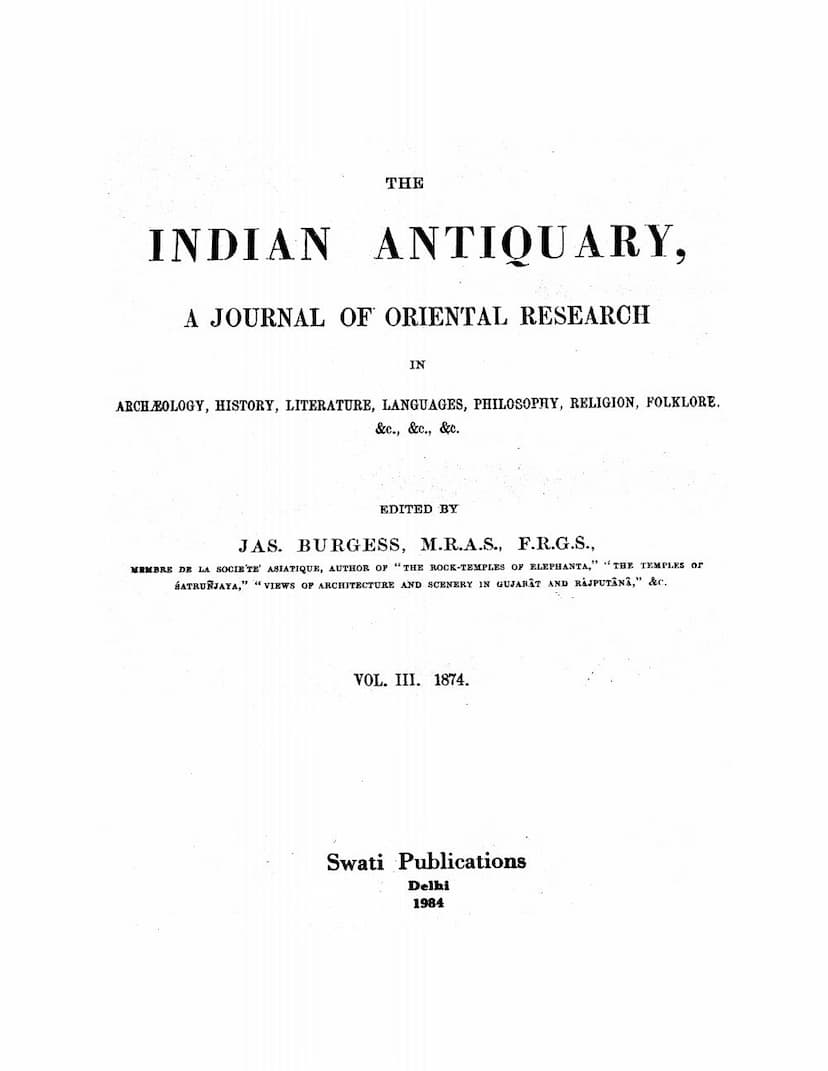Indian Antiquary Vol 03
Added to library: September 1, 2025

Summary
This is a comprehensive summary of the provided Jain text from the Indian Antiquary, Vol. III, 1874, edited by Jas. Burgess and published by Swati Publications.
The text is a collection of articles covering a wide range of Oriental research, with a significant focus on Indian archaeology, history, literature, languages, philosophy, religion, and folklore. While not exclusively Jain, it contains several entries and references relevant to Jainism, as well as broader discussions of Indian culture and history that provide context for understanding Jain traditions.
Here's a breakdown of the key themes and specific points of interest related to Jainism and its context within the volume:
Overall Scope and Structure:
- Journal of Oriental Research: The volume serves as a repository for diverse scholarly articles, indicating a broad interest in the various facets of Indian civilization during that period.
- Geographical and Subject Matter Diversity: Articles cover a wide geographical spread within India (Gujarat, Rajputana, South India, Bengal, Madras Presidency, Deccan, North-West Provinces, Konkan, etc.) and a vast array of subjects, including language, inscriptions, folklore, religious practices, historical accounts, and archaeological findings.
- Scholarly Contributions: The volume features contributions from numerous scholars, identified by their affiliations and expertise (e.g., M.A., M.C.S., Ph.D., Geological Survey of India, Elphinstone College, Madrasah, Tübingen University, etc.).
Points of Specific Interest to Jainism:
-
Page 3: Content Listing:
- J. G. Bühler, Ph.D., Educ. Inspector, Gujarat: "Letter: on the Bhandar of the Osval Jains at Jesalmer" - This is a direct reference to Jain communities and their traditions, specifically mentioning the "Bhandar" (storehouse or repository, likely of manuscripts) of the Oswal Jains in Jesalmer. This suggests an article detailing archival materials or religious customs related to this prominent Jain community.
- CAPT. CHARLES WODEHOUSE, Acting Judicial Assistant, Kathiawad: "SRAVAKA TEMPLE at BANTHALI" - This is another significant entry directly mentioning a "Sravaka" temple. Sravakas are lay followers of Jainism, and the existence of a temple dedicated to them at Banthali implies a discussion of Jain architectural or religious sites.
-
Specific Article Content (as indicated by titles):
- J. G. Bühler's letter on the Bhandar of the Oswal Jains at Jesalmer: While the full text of the letter is not provided in the snippet, the title clearly indicates it's a scholarly communication about Jain religious literature and potentially their archival practices in a significant Jain center. The mention of "Oswal Jains" highlights a specific and historically important Jain community.
- "SRAVAKA TEMPLE at BANTHALI" by Capt. Charles Wodehouse: This title directly points to an article on a Jain religious structure. The term "Sravaka" specifically refers to lay adherents of Jainism. The location at Banthali likely refers to a historically significant site for Jainism.
-
Broader Contextual Relevance to Jainism:
- General Discussions on Indian Religion and Philosophy: The volume contains numerous articles on Brahmanical religion, Hinduism, Buddhism, and various other Indian philosophical and religious traditions. These provide essential context for understanding Jainism within the broader landscape of Indian religious history. For example, discussions on Veda study, Krishna worship, and the origins of festivals offer comparative perspectives.
- Archaeological Findings: Articles discussing ancient temples, inscriptions, and ruins (like those at Ajanta, Sanchi, Amravati, and the "Bhilladigadh" mentioned in the Dabhi clan notes) shed light on the historical periods and geographical regions where Jainism also flourished, allowing for potential connections or comparisons.
- Social and Cultural Practices: The detailed notes on castes, marriage customs, and village life provide insights into the societal norms and traditions within which Jain communities functioned, offering a richer understanding of their historical context.
Summary of Jain-Related Content:
The Indian Antiquary, Vol. III, as presented in these pages, demonstrates a keen interest in the diverse religious and cultural landscape of India. Specifically concerning Jainism, it highlights:
- The importance of the Oswal Jain community: Bühler's letter focuses on their "Bhandar" in Jesalmer, suggesting a study of their religious literature and traditions.
- The existence of Sravaka temples: Capt. Wodehouse's article on a Sravaka temple at Banthali indicates the presence and significance of Jain religious architecture and lay patronage in that region.
These entries, though seemingly isolated within the larger volume, represent significant contributions to the understanding of Jain history and practice during the period. The volume's overall commitment to detailed research across various domains of Indian studies provides a robust framework for appreciating these specific Jain-related findings.